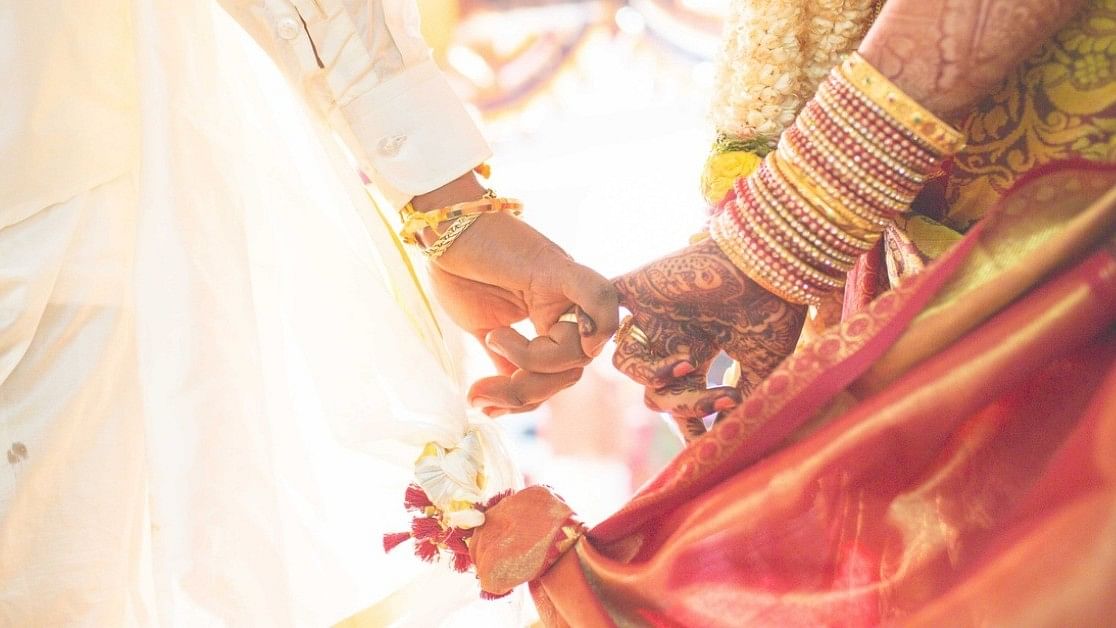
Representative image of a marriage.
Credit: iStock Photo
The word for a TV remote is marote; for chicken, it’s chimpken, and for the Aperol Spritz cocktail it’s app-a-ball spitz-ee. Shrimp is swimps, hair ties are hair gigglies and Starbucks is Starbonks.
All of these are examples of so-called marriage language, the weird and oftentimes embarrassing dialects people in long-term relationships develop to communicate with their partners.
It’s typically a mishmash of inside jokes (giving friends and family members nicknames) and purposeful malapropisms (slipping up and mispronouncing bird as birb), plus faux abbreviations (a shower is a show show, spinach becomes spinch) and code words for cruder terms (every couple seems to have their own word for passing gas).
Most people give their partner affectionate nicknames, and as many as two-thirds of couples use romantic baby talk to signal closeness. Marriage language is the natural extension of these behaviors, a personalized lexicon built up between two people who have spent so much time together that they’ve started using their own dialect.
Lilianna Wilde and Sean Kolar, musicians and content creators from Los Angeles who have been married for almost five years, said that their marriage language started to develop when they first moved in together after a year of long-distance dating. First came “show show” — Sean’s nickname for a shower. Then there was chick rotiss for a rotisserie chicken, pantaloons for jeans and an oopsie for a sidewalk curb.
“I think when you’re with a significant other you’re so comfortable with them and you can fully be yourself and the weird voices come out,” Kolar said.
The duo posted a video on TikTok to share the words they’d developed and hashtagged it “#marriagelanguage.” That video, with more than 3.6 million views, spawned a host of similar ones featuring couples revealing their own embarrassing terms. (Who knew so many people had their own nicknames for Starbucks?) The hashtag #marriagelanguage has since been viewed on TikTok nearly 30 million times.
Dr. Richard Slatcher, a behavior and brain sciences professor at the University of Georgia, has spent the majority of his career researching the social psychology behind close relationships, including how language forms and is used between intimate partners. He said the #marriagelanguage trend is really “getting at ways that we express affection for other people.”
“I think we do this as a way to form connections with other people,” Slatcher said. “When we do this in our intimate relationships, it’s a sign of trust — trust that you won’t share each other’s pet names with the world — and also a sign that our relationship is special.”
Slatcher said he is part of this phenomenon, too. “Early in our relationship, my wife and I liked to play a lot of Scrabble, and you know how sometimes you see a word and it just doesn’t look right? My now-wife put down a word and I looked at it and I went, ‘“Two” is not a word,’” he said, pronouncing “two” as if it rhymed with “toe.” “We will probably at least once a year refer to twoe.”
He added: “In this way these words are like a teeny, tiny little story, a symbol of a story. When I say twoe to my wife, she knows exactly what it means.”
Idiosyncratic communication within a couple can be an indicator of relationship satisfaction, according to one study published in The Journal of Social and Personal Relationships. Happier couples are more likely to have their own dictionary of secret words and nicknames, indicative of the exclusive bond they share.
Part of the intimacy of pet names and marriage language is that it’s a shared secret, something meant to be revealed only within the comfortable confines of your relationship. But for Wilde and Kolar sharing their marriage language publicly has actually made them feel closer to each other. Slatcher said he was not surprised. Self-disclosure, or sharing secrets, is actually one of the most common ways people create connections.
Though the #marriagelanguage TikTok trend has focused primarily on couples’ vernaculars, the phenomenon of developing our own dialects is not exclusive to romantic couples — we do it with our friends and families, too.
“Probably another one of the earlier ones was our word for toes, which is toezina marinas, and that comes from my grandma,” Wilde said. “So I guess in a way our early introduction to marriage language was bringing what we had from our own families and bringing it into our new family.”
Slatcher said that his wife’s family had always referred to medicine as mekkie, and that he and his wife started using that term with their children. In this way, marriage language can actually be passed down through generations the way other languages are.
Though couples like the Wildes may be comfortable sharing their relationship lexicon with the world, others are less eager. As one person put it on X, formerly known as Twitter, “Long-term relationships are all about developing a dialect so embarrassing you’d rather be shot than have audio of your daily conversations leak.”